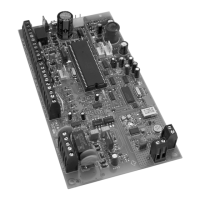
Do you have a question about the Spectra 1759ex and is the answer not in the manual?
| Brand | Spectra |
|---|---|
| Model | 1759ex |
| Category | Control Panel |
| Language | English |
Details specifications for the Spectra 1759EX control panel, including power, outputs, and approvals.
Details specifications for Spectra keypads (1686H, 1686V, 1689, 1641), including power and current consumption.
Provides guidance on selecting an appropriate location and mounting the control panel for optimal performance.
Instructions for connecting and installing a backup battery to ensure system operation during power loss.
Information on using auxiliary power terminals to supply power to keypads and other modules.
Details on connecting and programming the control panel's programmable outputs (PGMs) and alarm relay.
Explains how to define zone parameters including type, partition assignment, and reaction to alarms.
Describes various zone definitions like Entry Delay, Instant, Follow, and 24-hour zones.
Details on configuring zone options such as Auto Zone Shutdown, Bypass, Stay Zones, and Alarm Types.
Step-by-step guide for assigning and programming wireless transmitters to the Spectra 1759EX system.
How to check the signal strength of installed wireless transmitters for optimal placement.
Configures supervision settings for wireless transmitters, including check-in and low battery monitoring.
Details how to program the functions of remote control buttons for various system operations.
Explains how to program automatic arming of partitions at scheduled times.
Allows partitions to arm automatically if no movement is detected for a specified period.
Sets the time allowed for users to leave the premises after initiating an arming sequence.
Configures how long the bell or siren will sound during an alarm condition.
Enables or disables tamper detection and reporting for zones and keypads.
Defines the behavior (silent/audible) of panic alarms triggered via keypad combinations.
Details on programming specific codes for various system events to report to a central station.
Programming the primary and backup telephone numbers for central station communication.
Describes various reporting formats like Ademco Express, Contact ID, and Pager formats.
Enables system monitoring of the telephone line presence and reports line failures.
Allows programming specific system events to trigger a PGM output.
Defines events or delays that will return a PGM to its normal state.
Instructions for performing a hardware reset to restore control panel settings to factory defaults.
Enables dividing the system into two independent partitions for separate management.
Monitors the on-board tamper status of keypads and reports any tampering events.
Provides shortcuts for common installer tasks like test mode, call WinLoad, and cancel communication.
Configures supervision settings for wireless transmitters, including loss and bypass options.
Defines how the control panel answers incoming calls from the WinLoad software.
Explains how to view and interpret system trouble conditions indicated on the keypad.
Instructions for programming, deleting, and managing user access codes for system operation.
Steps for disarming the system or deactivating an active alarm using an access code.
Describes the standard method for arming the system, including exit delay.
Explains how to arm the system while allowing access to certain areas, like bedrooms.
Switches armed zones to instant status to provide immediate alarm on breach.
Allows arming the system even with open zones by bypassing them.
Enables users to manually bypass specific zones before arming the system.
Allows arming the system by pressing and holding a single key, without an access code.
Describes the three types of panic alarms (Emergency, Medical, Fire) and their activation.
Enables keypads to emit a chime sound when specific zones are opened.
Allows disabling most keypad beeps, except for key presses and confirmation/rejection beeps.
Allows users to modify the backlight level of the keypad for better visibility.
Important information regarding FCC compliance, radio frequency energy, and installation guidelines.
Guidelines for UL/ULC compliant installations, including component requirements and feature limitations.